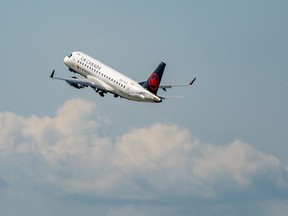
Article content
MONTREAL — Barry Choi has been noticing fewer filled seats on some of his flights over the past year.
Article content
Article content
“People are travelling a little bit less,” said Choi, who runs the Money We Have personal finance and travel website, which has him on a plane every four to six weeks.
The trend is one he wouldn’t have anticipated two years ago, when the urge to get away was nearly palpable after COVID-19 border closures ended and air travel became possible once more.
Advertisement 2
Article content
“Because of that pent-up demand from the pandemic, people kind of took their trips. In 2022, I feel like everyone was travelling. Everyone was like, ‘I’ve got to get it out.’
“Some people waited until 2023, but this year everyone’s kind of calmed down,” he said.
That pattern looks likely to persist in December and January. After turning abroad for holiday vacations last year, more Canadians are keeping their travel plans in-country this Christmas season due to squeezed budgets, lower domestic fares and a decisive end to the post-pandemic boom in overseas travel — and now a slumping currency.
The number of Canadian flights bound for the United States this December is slated to fall 2.5 per cent year-over-year, according to figures from aviation tracking firm Cirium.
Meanwhile, domestic flight capacity is set to jump nearly 10 per cent this month compared to December 2023.
The extra flight capacity north of the border has helped push down prices even as demand goes up, with fares on flights within Canada sitting 20 per cent lower than the year before as of September, the latest month for which Cirium had data.
Article content
Advertisement 3
Article content
Spokesman Mike Arnot said fewer flights to the U.S. — from all Canadian carriers except Porter Airlines, which is rapidly building its fleet and flying south — means “higher airfare generally,” as capacity falls further than demand.
Wallet worries have reined in spending somewhat, with gen Zers and millennials thinking twice before shelling out big bucks on experiences, travel included.
“We can’t ignore the fact that people are pinched. Interest rates are starting to go down, inflation is a little more in check, but still the cost of housing, cost of living are top of mind,” said Ramzi Rahbani, a vice-president at FlightHub.
A survey from the travel platform found that slightly more than half of Canadians are planning to hold off on trips over the holidays.
Thoughts about steering clear of the U.S. may loom larger after the loonie, which was already hovering near 72 cents US, slipped to its lowest exchange rate in years following president-elect Donald Trump’s proposal for a 25 per cent tariff on imports from Canada.
“I’m getting a lot of people thinking, ‘Do I still want to go to the U.S.?”‘ said Choi.
Advertisement 4
Article content
Canadians who normally decamp for Florida, Arizona and California during the winter are among those who would feel the weaker dollar most strongly.
“For snowbirds, the U.S. has definitely become more expensive,” said Jill Wykes, a travel expert who was speaking from Sarasota, Fla.
“All kinds of people had credit for things that had been cancelled in 2020 and 2021, especially cruise lines.” Those vouchers and travel credit are now spent.
Millennials — who now outnumber baby boomers in Canada — and gen Z together comprise more than half of all passengers, according to FlightHub. They cited family visits as the biggest reason for air travel over the holidays, which helps explain the domestic turn.
Overseas, the capitals of the Philippines and India — Manila and New Delhi — saw some of the highest booking numbers from Canada between Dec. 20 and Jan. 1, according to FlightHub.
“They tend to be returning to see family and friends too,” said Rahbani. Meanwhile, leisure-heavy trips to some sun destinations have plateaued.
Despite the shift toward domestic travel, many broad patterns remain in place. For those venturing south, New York City, Florida and California remain the top destinations across virtually all age groups.
Advertisement 5
Article content
“It’s stabilized,” said Richard Vanderlubbe, founder of travel agency Tripcentral.ca, referring to travel habits generally. But that similarity to 2023 is itself a big change from recent years, which saw wild swings in customer volumes as COVID-19 restrictions came and went.
While passenger numbers at Canada’s eight largest airports rose four per cent year-over-year in October, that only slightly outpaced population growth, according to Statistics Canada. And the five per cent increase in air travellers since 2019 fell short of the 10 per cent growth in population over that period, meaning volumes are down on a per capita basis.
Nearly a quarter of FlightHub’s customers said they budgeted between $1,000 and $2,000 for holiday travel. Another 22 per cent set aside between $500 and $1,000, and most of the rest socked away less than $500.
This report by The Canadian Press was first published Dec. 8, 2024.
Article content
